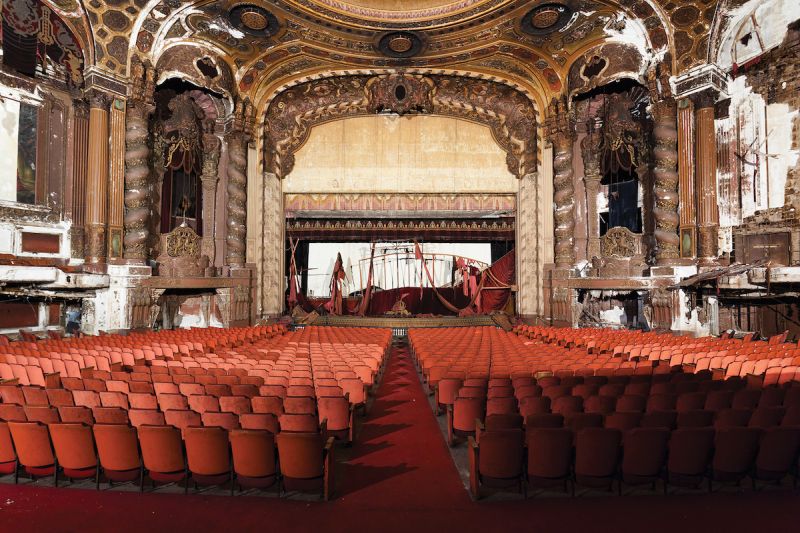By Jeniffer M.Wood
Take a peek inside architectural photographer Matt Lambros’s new book, After the Final Curtain: The Fall of the American Movie Theater, which pays tribute to the once-lavish movie palaces of yesteryear.
For more than 100 years, movie theaters have been the place where people’s Technicolor dreams come true. But as technology has advanced and the age of streaming has engulfed us, many of the world’s most lavish movie palaces have been demolished, repurposed, or outright abandoned. Yet there’s still something compelling and magical about these long-dormant spaces—even those that have been left to crumble. Matt Lambros certainly sees it.
The Brooklyn-based architectural photographer has long had an interest in capturing the haunting beauty of these once-opulent places, which he has captured in a gorgeous new book from Jonglez Publishing, After the Final Curtain: The Fall of the American Movie Theater, which includes photographs and historical information from two dozen theaters across the country.
Lambros gave us an exclusive peek at some of the photos, which you can view below. To see more of Lambros’s work, visit his website or follow him on Instagram.

State Palace Theatre in New Orleans, Louisiana opened on April 3, 1926. It eventually became a live performance venue. After closing due to the damages caused by Hurricane Katrina, the theater reopened sporadically as a rave venue. It was shut down on February 15, 2007 due to fire code violations.

The Uptown Theatre originally opened on February 16, 1929 in the North Central neighborhood of Philadelphia, Pennsylvania. The 2040-seat theater was designed by the architectural firm of Magaziner, Eberhard and Harris. Stevie Wonder, The Jackson 5, The Temptations, Ray Charles, Smokey Robinson, Marvin Gaye, and the Supremes all performed at the theater.

The Loew’s Kings Theatre in Brooklyn, New York opened on September 7, 1929 and closed almost 50 years later in 1977.

The Loew’s Kings Theatre was restored and reopened in early 2015 as the Kings Theatre.

The Liberty Theatre opened on February 11, 1918 in Youngstown, Ohio. It was designed by architect C. Howard Crane, later known for designing the Fox Theatre in Detroit, Michigan. It closed in 1976, and was demolished in 2013 after a few failed restoration efforts.

The Studebaker Theatre is located in the Fine Arts Building in Chicago, Illinois. Converted to a theater from a hall in 1898, the Studebaker became a movie house almost 100 years later in 1982. It closed in 2000, and has since been renovated. It reopened in October 2015.

The Adams Theatre in Newark, New Jersey originally opened on January 12, 1912 as the Shubert Theatre. It closed on March 31, 1986 due to a 400 percent increase in the insurance rates, which also caused the nearby Paramount Theatre to close.

The Warner Theatre in Huntington Park, California opened on November 19, 1930. It was sold to Pacific Theatres in 1968. They twinned the Warner in the 1980s, separating the balcony and orchestra levels, and renamed it Pacific’s Warner 2. The Warner closed in the early 1990s after a stint as a Spanish language theater.

The Carolina Theatre opened on March 7, 1927 in Charlotte, North Carolina. It closed on November 27, 1978 and was damaged by a fire a few years later. The lobby and façade were demolished in the 1990s. It was sold to the Foundation for the Carolinas in 2013 for $1.00. FFTC intends to restore the theater as a performing arts center.

Loew’s Poli’s Theatre opened on September 4, 1922 in Bridgeport, Connecticut. Originally called Poli’s Palace Theatre, it was bought by Loew’s in 1934 and the name was changed to the Loew’s Poli Theatre. Loew’s sold the theater in the early 1970s and after showing adult films for a few years, the Palace closed permanently in 1975.

The Boyd Theatre, downtown Philadelphia’s only Art Deco movie palace, opened on Christmas Day in 1928. One of the companies commissioned for the Boyd’s interior decoration was the Rambusch Company, who later decorated the Loew’s Kings Theatre. The theater closed and was slated for demolition in 2002 before a group of concerned citizens formed the “Committee to Save the SamEric” (which later became “Friends of the Boyd”) to save the theater from demolition. In the past 10 years, several attempts were made to restore the theater, without success. The auditorium was demolished in early 2015.

The Pantheon Theatre opened in May 1921. Red Skelton, who was born in Vincennes, Indiana, performed at the theater when he was first starting as a comedian. The theater closed in the mid-1960s and the current owners plan to reuse the space as a lecture hall/training center.

The Gem Theatre in Cairo, Illinois opened in 1934 and was built on the site of an older theater. It closed in 1978, and sits vacant to this day.

Loew’s Canal Theatre opened in September 1927 in New York, New York. On the morning of September 10, 1932, an explosion rocked the front of the Loew’s Canal, throwing the ticket booth into the street and shattering windows on a number of neighboring buildings. No one was injured in the blast, but Edward Brown, the theater’s night watchman, was thrown down a flight of stairs by it. A similar explosion destroyed the entrance of the Loew’s 46th Street Theatre an hour earlier. Both bombings were thought to be connected to the Motion Picture Operators’ Union Local 306, who were on strike at the time and protesting in front of both theaters, but nothing was ever proven. It is currently used as a warehouse.

The Capitol Theatre in New London, Connecticut opened in 1926 as a vaudeville theater. It closed in 1974. The current owner is investigating a number of options for the future of the Capitol.




